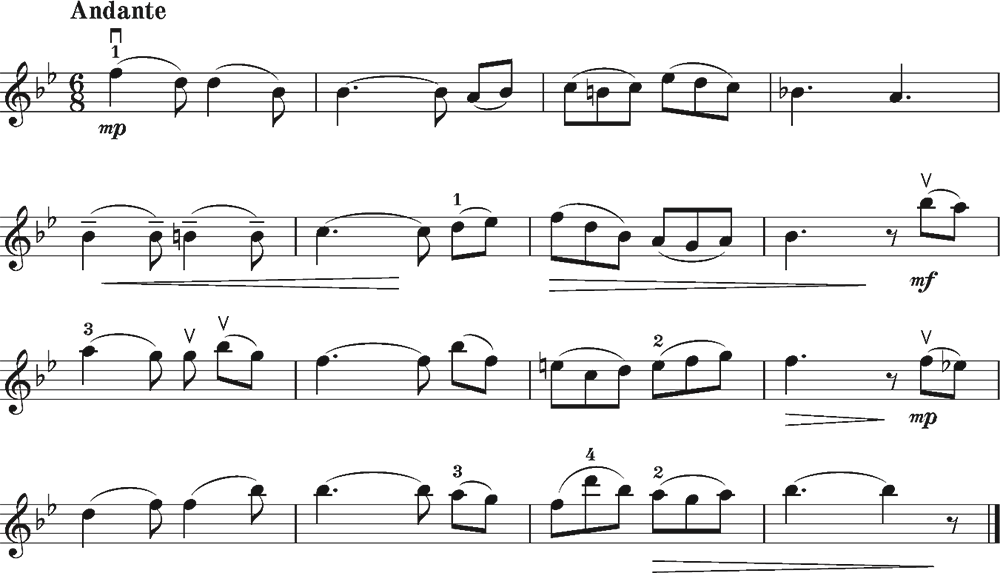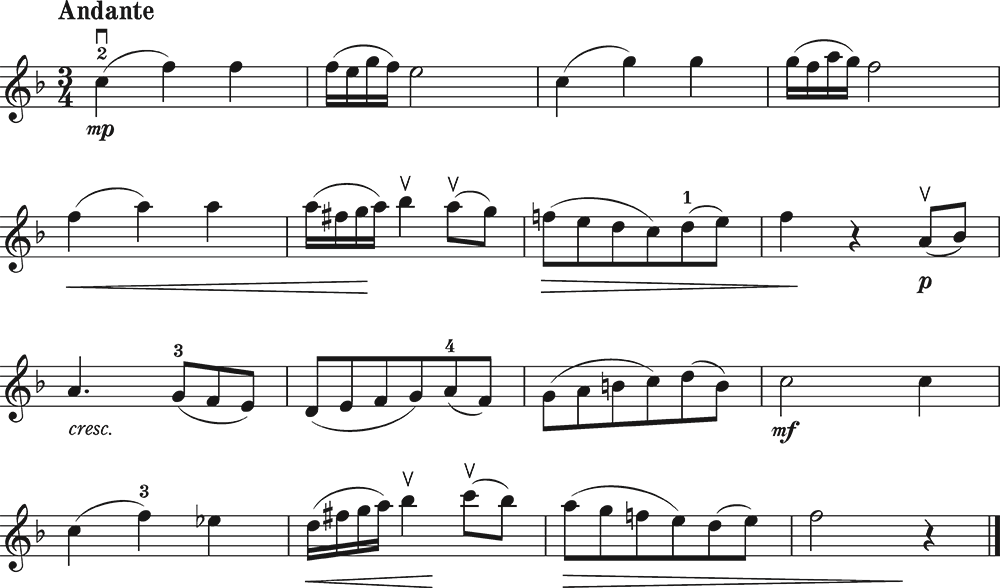Violin Grade 13-6
Examination Procedure
Duration
Grades 13-8: 15 minutes, Grades 7, 6: 20 minutes
Instrument and Tuning
Candidates are expected to bring the instrument and equipment needed for the exam.
Candidates are expected to tune their instrument to A=442Hz on their own.
If candidates have a problem with their instrument during the exam, for example, a broken string, a spare instrument prepared in the exam room may be used. Candidates are expected to solve any problems prior to the exam on their own.
Subject Details
I. Repertoire
I-I. Compulsory Piece
Candidates prepare one piece from the Compulsory Piece List and play it.
Procedure
1. Grades 13-8: Examiners play the beginning of the backing track for several bars so that the candidate can play along to set an appropriate volume and balance.
2. Candidate plays the piece.
- Note:
- Candidates are allowed to use the score if necessary.
- For Grades 13-8, the backing track files are prepared at the exam room.
- For Grades 7 and 6, candidates are expected to play without any accompaniment.
- For Grades 7 and 6, it is not necessary for candidates to play the repeats.
- For Grades 7 and 6, various interpretations are acceptable for bowings and fingerings.
- Examiners may stop the performance before it reaches the end of the piece.
Compulsory Piece List
Grade 13
Book 1 - Unit 3 : Aura Lee (American Folk Song)
Book 1 - Unit 3 : Cantata (J. S. Bach)
Book 1 - Unit 3 : Sonata for Piano, A Major (W. A. Mozart)
Grade 12
Book 1 - Unit 5: Annie Laurie (Scotland Folk Song)
Book 1 - Unit 5: Ode to Joy (Violin I) (L. v. Beethoven)
Book 1 - Unit 6: Suite BWV.822 (Violin I) (J. S. Bach)
Grade 11
Book 2 - Unit 1: Bourrée (G. F. Händel)
Book 2 - Unit 2: On Wings of Song (F. Mendelssohn)
Book 2 - Unit 2: Gavotte (J. S. Bach)
Grade 10
Book 2 - Unit 4: La Follia (A. Corelli)
Book 2 - Unit 6: Gavotte (F. J. Gossec)
Book 2 - Unit 6: Bourrée (J. S. Bach)
Grade 9
Book 3 - Unit 1: Le Cygne (C. C. Saint-Saëns)
Book 3 - Unit 2: Symphony No.6 “Pathetique” (P. I. Tchaikovsky)
Book 3 - Unit 3 : Londonderry Air (Irish Folk Song)
Grade 8
Book 3 - Unit 4: Sicilienne Op.78 (G. U. Fauré)
Book 3 - Unit 5: Andantino (Violin I) (J. P. E. Martini)
Book 3 - Unit 6: Salut d’amour (E. Elgar)
Grade 7
Sonata No.4 in D Major Op.1-13, 1st and 2nd Movement * (G. F. Händel)
Sonata in G Minor, 1st and 2nd Movement * (H. Eccles)
Concerto No.1 in A Minor BWV.1041, 1st Movement * (J. S. Bach)
Grade 6
Sonata No.5 in F Major “Spring” Op.24, 1st Movement * (L. v. Beethoven)
Concerto No.23 in G Major, 1st Movement * (G. B. Viotti)
Concerto No.2 in E Major BWV.1042, 1st Movement * (J. S. Bach)
*Please refer to the PDF scores.
I-II. Free Selection (Except Grades 13 and 12)
Candidates prepare one free selection piece and play it.
Points to consider when selecting a piece to prepare for Free Selection:
The level of the Free Selection piece is expected to be equivalent to the level of the Compulsory Pieces and Examples Pieces (see list below) for the Grade.
Candidates may choose a Free Selection piece from the textbook (Grades 11-8) or the Compulsory Piece List provided that it is not the same piece they have prepared for the Compulsory Piece selection.
Procedure
1. Candidate informs the examiners whether or not they will play along with a backing track.
2. If the candidate plays along with the backing track, examiners play the beginning of the backing track for several bars so that the candidate can play along to set an appropriate volume and balance.
3. Candidate plays the piece.
- Note:
- Candidates are expected to bring the scores of the pieces they have prepared to the exam.
- Examiners may ask to see the score.
- Candidates are allowed to use the score if necessary.
- Candidates are allowed to choose whether or not to play along with a backing track.
- a) If candidates choose a piece from inside the textbook, the backing track will be prepared at the exam room.
- b) If candidates choose a piece outside of the textbook and will play a piece along with a backing track, candidates are expected to bring the MP3 files or MIDI data.
- It is not necessary for candidates to play the repeats for the non-textbook repertoire.
- Examiners may stop the performance before it reaches the end of the piece.
Examples of Free Selection
Grade 11
Minuet in G Major BWV.Anh.114 (J. S. Bach)
Minuet in G Major BWV.Anh.116 (J. S. Bach)
Waltz Op.39-15 *in G major (J. Brahms)
Grade 10
Minuet (L. Boccherini)
Minuet in G Major WoO.10-2 (L. v. Beethoven)
Gavotte en Rondeau in G minor BWV.822 (J. S. Bach)
Melody in F Op.3-1 (A. Rubinstein)
Grade 9
Serenade Op.3-5 (R. Hoffstetter (Haydn))
Minuet K.64 (W. A. Mozart)
Gavotte en Rondeau *in A minor (J. B. Lully)
La Cinquantaine (G. Marie)
Concerto in A Minor Op.3 No.6, 1st Movement (A. Vivaldi)
Concerto in A Minor Op.3 No.6, 3rd Movement (A. Vivaldi)
Grade 8
Sonata No.3 in F Major Op.1-12, 1st and 2nd Movement (G. F. Handel)
Concerto for Two Violins in D Minor BWV.1043, 1st Movement (J. S. Bach)
Concerto No.5 in D Major Op.22, 1st Movement (F. Seitz)
Concerto No.5 in D Major Op.22, 3rd Movement (F. Seitz)
Concerto No.2 in G Major Op.13, 3rd Movement (F. Seitz)
Grade 7
Tempo di Minuetto (in the style of Pugnani) (F. Kreisler)
Humoresque Op.101 (A. Dvořák)
Allegro in G Major Op.1-10 (J. H. Fiocco)
Cavatina Op.85-3 (J. Raff)
Sicilienne Op.78 (G. Faurè)
Après Un Rêve Op.7-1 (G. Faurè)
Grade 6
Meditation from “Thais” (J. Massenet)
Partita No.3 in E Major BWV. 1006, Gavotte en Rondeau (J. S. Bach)
Romance No.2 in F Major Op.50 (L. v. Beethoven)
Cantabile (N. Paganini)
Souvenir d'un Lieu Cher [Mélodie] Op.42-3 (P. I. Tchaikovsky)
*This key is required.
II. Sight Playing
Examiners select one piece and ask the candidate to play it by sight.
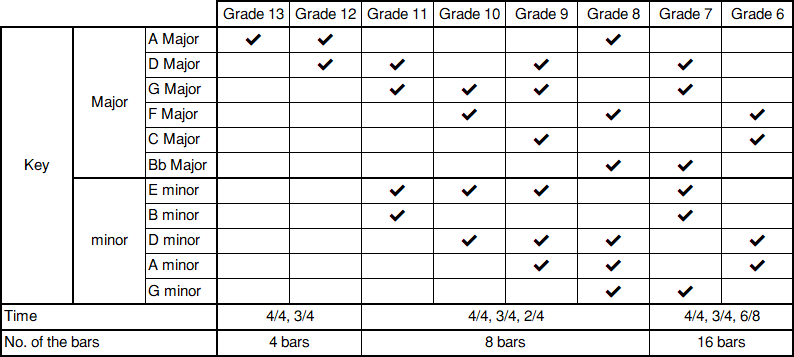
Procedure
1. Candidate is presented a score of the exam piece.
2. Candidate is given 30 seconds to look at the score as preview.
3. Candidate plays the piece after the examiner’s cue.
- Note:
- Movements, such as playing without sound, fingering etc., are not allowed during preview time.
Examples
III. Aural Playing
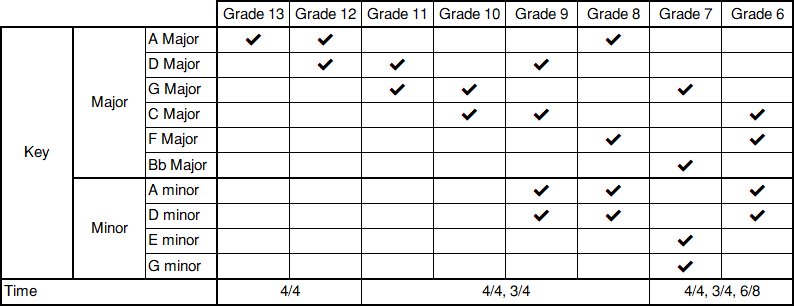
Procedure
1. Examiners select one piece for the candidate to play by ear.
2. Examiners inform the candidate of the key and time signature verbally prior to playing.
3. Examiner demonstrates the complete piece (4 bars).
4. Examiner divides the piece in half and play 2 bars at a time.
5. Candidate imitates 2 bars at a time immediately after the examiner’s cue.
Examples
IV. Scales and Bowing Variations (Grades 13-10)
Candidates play one (Grades 13, 12), two (Grades 11, 10) scale(s) and one bowing variation selected by the examiners without the use of a score.
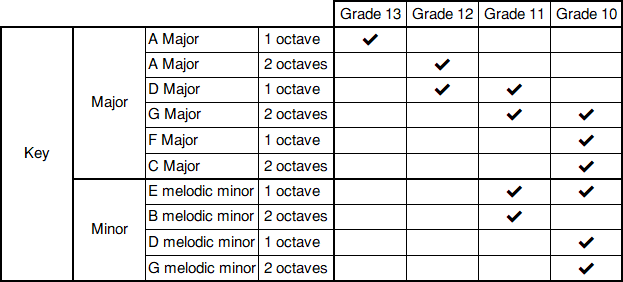
Procedure
1. Examiners give candidate information on the type, key, range and starting note of the scale to be played.
2. Candidate plays the scale as required.
3. Examiners select one bowing variation out of two given variations and show it to the candidate.
4. Grades 13, 12: Candidate plays the same scale in the same key as procedure 1 using the given bowing variation.
Grades 11, 10: Candidate plays one of the two scales in the same key as procedure 1 using the given bowing variation.
- Note:
- Candidates are not allowed to use scores during the exam.
- The last note of ascending/descending may be played longer than the other notes.
- The tempo noted in the score is the suggested tempo. However, the ability to play at a steady tempo is what is being evaluated.
- The scales are to be played with no vibrato.
V. Scales and Arpeggios (Grades 9-6)
Candidates play two scales and one arpeggio selected by the examiners without the use of a score.
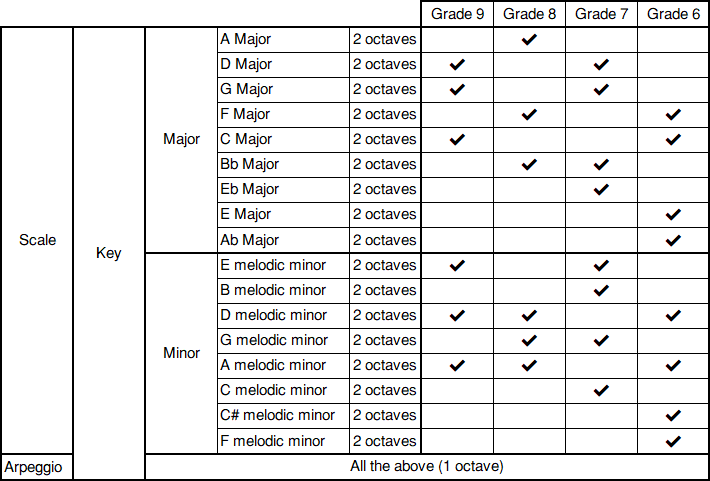
Procedure
1. Examiners give candidate information on the type, key, range and starting note of the scale to be played.
2. Candidate plays the scale as required.
3. Examiners select one arpeggio in the same key as one of the two scales chosen in procedure 1.
4. Candidate plays the arpeggio as required.
- Note:
- Candidates are not allowed to use scores during the exam.
- The last note of ascending/descending may be played longer than the other notes.
- The tempo noted in the score is the suggested tempo. However, the ability to play at a steady tempo is what is being evaluated.
- The scales are to be played with no vibrato.








